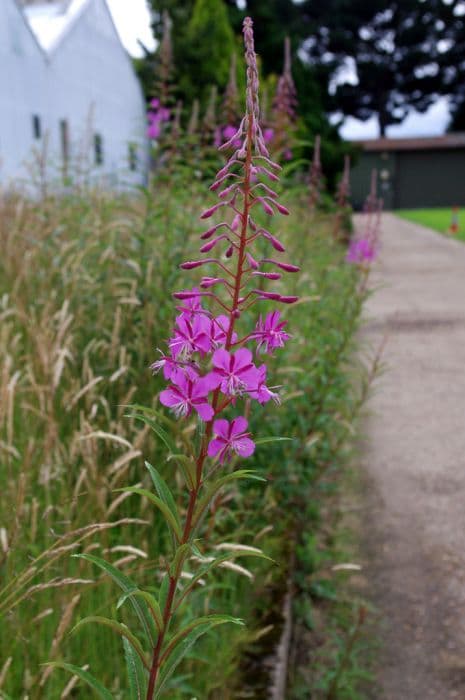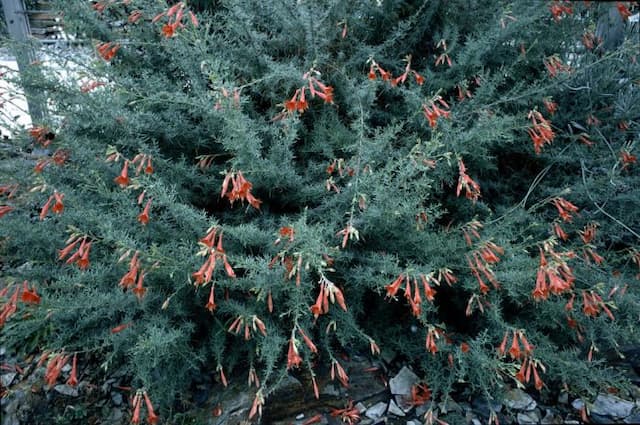White Gaura Oenothera lindheimeri Karalee White = 'Nugauwhite' (PBR) (G)

ABOUT
The plant known as Gaura Karalee White presents a graceful and delicate appearance with its slender stems that play host to a profusion of butterfly-like flowers. The overall visual effect of the plant is one of lightness and airiness. The flowers are predominantly white with a hint of blush pink at the bud stage, transitioning to pure white as they mature. Blossoms feature four distinct, lobed petals arrayed in a cross shape around a set of prominent stamens that often protrude, giving an attractive contrast against the petals. The foliage of the Gaura Karalee White is also noteworthy, consisting of lance-shaped leaves that are finely textured and sometimes tinged with pink or red hues, especially during cooler temperatures. The leaves usually grow in a rosette-like formation at the base of the plant, providing a lush green backdrop that further highlights the purity of the white flowers. This plant also displays a notable characteristic of the flowers opening sequentially from the bottom to the top of the stems, which extends the period of visual interest as there are always some blooms open while others are still in the bud stage. In its overall form, Gaura Karalee White gives off an airy and relaxed vibe, often swaying gently in the breeze, enhancing its butterfly-like flower appeal. Its continued blooming habit throughout the warmer months provides a long-lasting and dynamic element to gardens, making it a popular choice for flower enthusiasts who wish to add a subtle, yet impactful, touch of elegance to their outdoor spaces.
About this plant
 Names
NamesFamily
Onagraceae
Synonyms
White Gaura, Lindheimer's Beeblossom, White Wand Flower, Karalee White Gaura
Common names
Gaura lindheimeri, Gaura lindheimeri Engelm. & A.Gray, Gaura lindheimeri var. leucantha Munz, Gaura parviflora Torr. & A.Gray var. lindheimeri (Engelm. & A.Gray) Shinners.
 Toxicity
ToxicityTo humans
The most common common name for Oenothera lindheimeri is Gaura. Generally, Gaura is not considered toxic to humans and does not have a history of causing poisoning when ingested. However, as with any plant, individual allergies or sensitivities could potentially cause mild reactions. If an individual had an unusual reaction to consuming Gaura, they should seek medical advice.
To pets
Gaura is the most common common name for Oenothera lindheimeri. This plant is not typically known to be toxic to pets such as dogs and cats. Ingesting parts of the plant would not normally lead to poisoning. If a pet ingests a large amount of the plant and exhibits unusual symptoms, it is advisable to consult a veterinarian. Symptoms of general plant toxicity in pets, while not specific to Gaura, can include vomiting, diarrhea, drooling, or lethargy.
 Characteristics
CharacteristicsLife cycle
Perennials
Foliage type
Deciduous
Color of leaves
Green
Flower color
White
Height
2 feet 4 inches [0.71 meters]
Spread
2 feet [0.61 meters]
Plant type
Herb
Hardiness zones
6
Native area
North America
Benefits
 General Benefits
General Benefits- Attractive Flowers: The Karalee White Oenothera lindheimeri produces beautiful white blossoms that can enhance the aesthetic appeal of gardens.
- Drought Resistance: This plant is drought-tolerant, making it a good choice for gardens in areas with water restrictions or dry climates.
- Low Maintenance: Oenothera lindheimeri Karalee White is relatively easy to care for and does not require frequent watering or intricate care routines.
- Pollinator Friendly: The flowers attract bees, butterflies, and other pollinators, supporting local ecosystems.
- Deer Resistance: This variety is known to be deer-resistant, which can be beneficial in areas where deer browsing is a problem for gardens.
- Long Blooming: It has a long blooming season, providing flowers from early summer through fall for extended interest.
- Versatile Landscaping: Can be used in borders, rock gardens, and container plantings, offering versatility in landscaping choices.
- Heat Tolerance: The plant is able to withstand high temperatures, making it ideal for hot and sunny locations.
 Medical Properties
Medical PropertiesThis plant is not used for medical purposes.
 Air-purifying Qualities
Air-purifying QualitiesThis plant is not specifically known for air purifying qualities.
 Other Uses
Other Uses- Gaura, as a tall plant with a long blooming period, is often used as a living privacy screen in gardens, creating a natural and aesthetically pleasing barrier.
- In permaculture designs, Gaura can function as an insectary plant, attracting beneficial insects that help to pollinate other plants or control pest populations.
- The Gaura's long stems and delicate white flowers can be used for casual homegrown flower arrangements, providing a touch of wilderness indoors.
- Its graceful dancing-in-the-breeze appearance has inspired artists and photographers to use Gaura as a subject for works or a backdrop in portrait photography.
- Gaura is sometimes planted in large public landscaping projects to provide movement and interest, thanks to its swaying flowers and foliage.
- The plant's resistance to deer browsing makes it suitable for gardens in areas where deer are a common garden nuisance.
- With its drought tolerance, Gaura can be incorporated into xeriscaping designs that aim to reduce or eliminate the need for supplemental water.
- Gaura can be used in educational gardens to teach about the importance of native plants in supporting local ecosystems and biodiversity.
- Dried Gaura flowers can be utilised in craft projects, such as making natural potpourri or as an inclusion in homemade paper for a decorative effect.
- As a companion plant in the vegetable garden, Gaura can help to draw pollinators which are essential for the fruiting of several vegetable species.
Interesting Facts
 Feng Shui
Feng ShuiThe Gaura is not used in Feng Shui practice.
 Zodiac Sign Compitability
Zodiac Sign CompitabilityThe Gaura is not used in astrology practice.
 Plant Symbolism
Plant Symbolism- Perseverance: Oenothera lindheimeri, commonly known as Gaura, symbolizes perseverance due to its ability to thrive in tough environments and its long blooming period.
- Purity: The white color of 'Karalee White' variety often represents purity and innocence.
- Transformation: Gauras have a unique flowering pattern that seems to change shape, symbolizing transformation and adaptability.
- Peace: With its delicate white flowers, Gaura can evoke a sense of calm and peace, much like the way white flowers are used in various cultures to symbolize tranquility.
 Water
WaterGaura, commonly known as Whirling Butterflies, should be watered sparingly as it is drought-tolerant. For newly planted Gauras, water them deeply once a week, providing about one inch of water to encourage deep root growth. Once established, Gauras require less frequent watering, and you can reduce watering to every two to three weeks, depending on the weather and soil conditions. Always check the top inch of soil for dryness before watering; if it's dry, it's time to water. Avoid overhead watering to minimize the risk of leaf diseases and aim for the base of the plant, supplying about 1-2 gallons each time during the growing season.
 Light
LightGaura thrives in full sun, where it can receive at least six hours of direct sunlight each day. The best spot for your Gaura is in an area that is exposed to the morning sun and has some light afternoon shade, particularly in hot climates, to prevent scorching. Avoid deep shade, as this will cause the plant to produce fewer flowers and can lead to leggy growth as it stretches towards the light.
 Temperature
TemperatureGaura flourishes in temperatures that range between 60°F and 90°F but can withstand temperatures as low as 20°F once established. It is a hardy plant that can survive summer heat provided it has enough water during prolonged dry periods. Ideal growing conditions involve warm days and cooler nights, which encourage vigorous growth and flowering. If temperatures consistently drop below 20°F, it's best to provide some form of frost protection to the plant.
 Pruning
PruningPruning Gaura helps maintain its shape, encourage bushier growth, and promote more blooms. Prune in early spring by cutting back the plant to about one-third of its size to remove any old, woody stems and to tidy up its appearance. Additionally, deadheading spent flowers throughout the growing season can stimulate the production of new blooms. The best time for major pruning is just before new growth begins, typically in late winter or early spring.
 Cleaning
CleaningAs needed
 Soil
SoilGaura, commonly known as White Gaura, thrives best in a well-draining soil mix with some sandy or gravelly material to enhance drainage. A good mix might consist of loamy garden soil, coarse sand, and peat or compost to retain some moisture while still providing aeration. The ideal soil pH for White Gaura is slightly acidic to neutral, ranging from 6.0 to 7.0.
 Repotting
RepottingWhite Gaura does not require frequent repotting and can often be left undisturbed for several years. Repotting every 2 to 3 years is generally sufficient unless the plant has outgrown its current pot or the soil has become compacted or depleted of nutrients.
 Humidity & Misting
Humidity & MistingWhite Gaura is a hardy plant that is not particularly sensitive to humidity levels. It thrives in average humidity conditions typical of outdoor environments and does not require any special humidity adjustments when grown outdoors.
 Suitable locations
Suitable locationsIndoor
Provide full light, minimal watering, well-draining mix.
Outdoor
Full sun, well-draining soil, drought-tolerant once established.
Hardiness zone
5-9 USDA
 Life cycle
Life cycleOenothera lindheimeri 'Nugauwhite', commonly known as White Gaura, initiates its life cycle as a seed which germinates in warm spring soil. Once sprouted, the plant enters a vegetative growth phase where leaves and stems develop, forming a bushy clump with lance-shaped foliage. As it matures through the growing season, it begins to produce tall flowering stalks adorned with delicate white blooms that attract pollinators; this flowering stage can last from late spring through autumn. After pollination, flowers develop into small nutlet-like fruits containing seeds, completing the reproductive cycle. As temperatures drop in late fall to winter, White Gaura enters dormancy, with above-ground growth dying back, while the root system remains alive to regenerate the next spring. This perennial may also spread through rhizomes, expanding its growth area over time.
 Propogation
PropogationPropogation time
Spring to early summer
Oenothera lindheimeri 'Karalee White', commonly known as White Gaura, is most effectively propagated by division during the spring. The process involves carefully digging up an established plant and gently separating the crown and root ball into multiple segments, ensuring that each new section has a healthy portion of roots attached. These divisions can then be immediately replanted into a well-draining soil mixture, ideally in a sunny location. Regular watering should follow to help the new plantings establish. This method allows gardeners to rapidly increase their stock of White Gaura while maintaining the genetic consistency of the ‘Nugauwhite’ cultivar.









